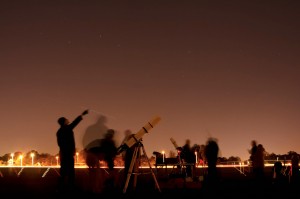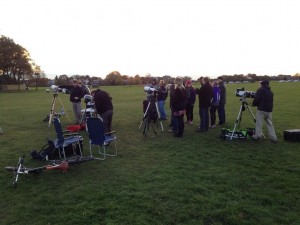November 10, 2013
Blackheath Stargazing – 10 November 2013
Report by: Mike Meynell
Pictures by Sumitra Sri Bhashyam, Daniel Berrange and Michael Kaye. Video by Sumitra Sri Bhashyam
Our regular monthly Blackheath Stargazing event had been scheduled for either Friday 8th or Saturday 9th November, depending on weather conditions. The huge amounts of rain that fell on Friday put paid to any hope of running an event on Friday evening. However, late on Friday evening, I was less than amused to see the skies clearing beautifully! It’s not the despair… it’s the hope that gets you.
Saturday evening was little better, with the sky covered in a blanket of cloud. It looked likely that there would be no Blackheath session in November. The weather had other ideas. The forecast for Sunday was for clear skies all day, but with clouds moving in during the late evening. We took the decision to run an “unplanned” event starting on Sunday afternoon, firstly to view the Sun, and then moving on to view Venus, the Moon and some other celestial objects before packing up early to avoid the clouds. The weather forecast proved to be entirely accurate for once, and a group of us gathered on Blackheath at 3pm on a chilly Sunday afternoon.
The views of the Sun were extremely interesting. Sunspot Region 1890 (AR11890), which has been responsible for 4 very energetic X-class solar flares, along with quite a few smaller events, was very prominent. I could count at least 15 separate spots in this region. Another smaller sunspot region could be seen on the eastern limb (AR11893). Very interesting to look at, particularly using a white-light filter on a refractor.
As the Sun began to set, we turned our attention to Venus. Venus is a particularly striking sight at the moment, low in the south-west at around sunset. It has just gone past maximum elongation from the Sun, so it is just under half-illuminated at present. It is certainly an object that is worth viewing over the next couple of months, as it gets closer to inferior conjunction, and the phase of Venus becomes more and more like a thin crescent.
Coincidently, the Moon was in an almost identical phase to Venus, just past first quarter, so around half-illuminated. A perfect time to view features such as the Vallis Alpes, one of the best examples of a lunar rift valley. One of the attendees likened it to a “monstrous civil engineering project” and it is difficult to disagree, as it cuts cleanly through the lunar Alps between two lunar Mare.
There was just enough time left to view a few other objects, Albireo the double-star in Cygnus being a particular favourite, and, of course, the always popular Double Cluster in Perseus. We tried to view a few fainter objects, such as M13, M31 and M57, but the skies were not dark enough and some of the high hazy cloud that had been forecast was starting to roll in.
Despite these disappointments, it was a really good session. It was great to see such a good response both from Flamsteed members and members of the public who saw the event “advertised” on social media. I’ve included a few photographs of the event in this report, taken by various attendees. Sumitra even managed to take a really nice timelapse video of the event, which I’ve included below.
Perhaps this may be the blueprint for more winter stargazing events… we certainly seemed to attract more participants by starting in the afternoon, and didn’t get too chilled by the very cold conditions after sunset!
Thanks to all those who came along, particularly those who brought equipment for people to use. It is always massively appreciated and we couldn’t run these events without you.
Let’s hope for clear skies at our next Blackheath event on 6 December.
Posted under: Blackheath, Flamsteed, Meeting Report, Public Solar Viewing







You must be logged in to post a comment.